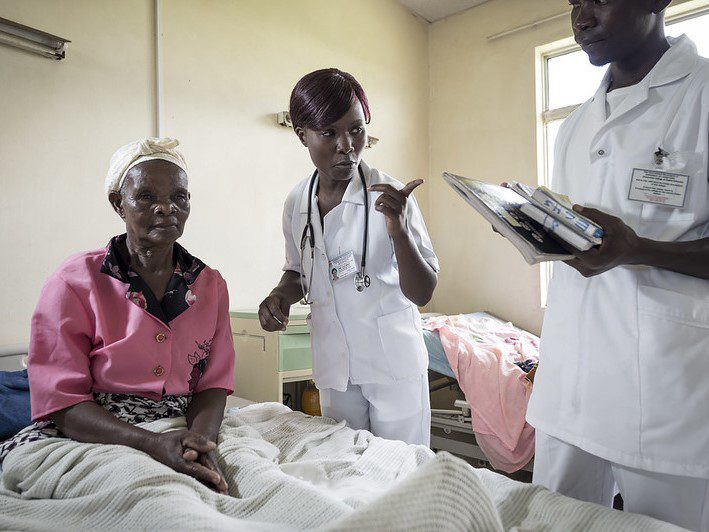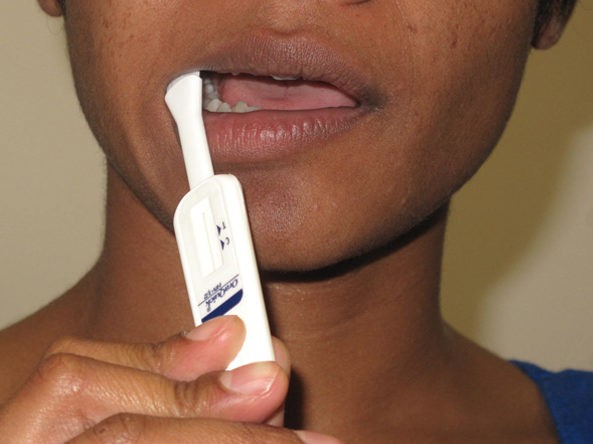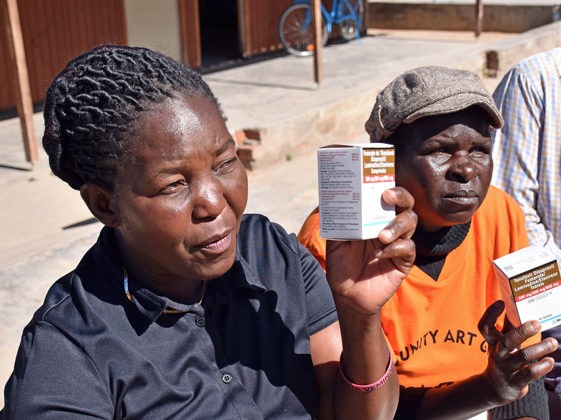Article and Study Summary:
Reduction in mortality from HIV-related CNS infections in routine care in Africa (DREAMM): A before-and-after implementation study
Published in:
Lancet HIV. 2023;10(10):e663-e673
https://doi.org/10.1016/S2352-3018(23)00182-0
Authors:
Prof Sayoki Mfinanga MD, Cecilia Kanyama MD, Charles Kouanfack PhD, Saulos Nyirenda MD, Sokoine Lesikari Kivuyo MD, Timothée Boyer-Chammard MD, Prof Sam Phiri PhD, Jonathon Ngoma MD, Meshack Shimwela MD, Daniel Nkungu MMed, Lauriane Nomene Fomete MD, Rehema Simbauranga MD, Chimwemwe Chawinga BSc, Nicaine Ngakam MD, Tom Heller MD, Sandrine Sa’a Lontsi MD, Elnara Aghakishiyeva MSc, Katri Jalava PhD, Sebastian Fuller PhD, Prof Anne-Marie Reid EdD, et al.
Summary
Driving Reduced AIDS-associated Meningoencephalitis Mortality (DREAMM) was a multi-center hybrid type 2 implementation science project with a before-and-after design, which aimed to develop, implement, and evaluate pragmatic implementation interventions and strategies to reduce mortality from HIV-related central nervous system (CNS) infection within routine hospital care in Cameroon, Malawi, and Tanzania. The main intervention was the implementation of a stepwise algorithm for HIV-related CNS infection, targeting the four main causes of HIV-related CNS infection (cryptococcal meningitis, tuberculous and bacterial meningitis, and cerebral toxoplasmosis). Implementation strategies focused on empowerment of local leadership and health system strengthening to improve the quality of care for HIV-related CNS infections. The primary outcome was the comparison of 2-week all-cause mortality among adults living with HIV presenting with suspected CNS infection before and after implementation of the intervention. All-cause mortality was found to be significantly lower during the implementation phase compared to the observation phase at 2 weeks follow-up. This study provides evidence that locally led health system strengthening in resource-limited settings is feasible and can be utilized to implement clinically proven interventions in routine care to reduce HIV-related mortality.
Discussion Questions:
1) How could the findings in this study impact policy where you work?
2) What would it take to implement the study intervention in the programs you work with? Do you have any experiences to share?
Please share your thoughts and experiences with us in the comments section below.
Full Synopsis:
PDF version available in English, French, and Spanish.
Study Summary
Driving Reduced AIDS-associated Meningoencephalitis Mortality (DREAMM) was a multi-center hybrid type 2 implementation science project with a before-and-after design, which aimed to develop, implement, and evaluate pragmatic implementation interventions and strategies to reduce mortality from HIV-related central nervous system (CNS) infection within routine hospital care in low-income and middle-income countries (LMIC).
Study Setting
- Five tertiary and secondary public health hospitals in Cameroon, Malawi, and Tanzania.
- Sites with local experts in research or implementation were chosen to lead the project and identify generalizable implementation interventions and strategies for HIV-related CNS infection.
- Centralized, acute-care hospital settings were chosen due to the need for expert clinical care, intensive monitoring, and commodity storage requirements.
Methods
- The project was divided into three sequential phases: observation, training, and implementation.
- The observation phase aimed to identify barriers and facilitators for HIV-related CNS infection care delivery and included documentation of existing practices and procedures and recording 2-week and 10-week mortality outcomes.
- The main intervention was the implementation of a stepwise algorithm for HIV-related CNS infection, targeting the four main causes of HIV-related CNS infection (cryptococcal meningitis, tuberculous [TB] and bacterial meningitis, and cerebral toxoplasmosis).
- Standard operating procedures from cryptococcal meningitis clinical trials were adapted for use in routine care settings, using a syndromic approach to HIV-related CNS infection management.
- The algorithm featured bedside rapid diagnostic testing by clinical staff, done in parallel with laboratory testing using standard microbiological techniques; and the implementation of the 2018 World Health Organization cryptococcal meningitis guidelines.
- All participants received cryptococcal antigen (CrAg) lateral flow assay in blood and cerebrospinal fluid and urinary lipoarabinomannan testing.
- In Malawi and Tanzania, 1 week of amphotericin B deoxycholate (1 mg/kg per day) plus oral flucytosine (100 mg/kg per day) followed by 1 week of high-dose fluconazole (1200 mg daily) was implemented as first-line therapy for cryptococcal meningitis. The alternative oral regimen of 2 weeks of high-dose fluconazole (1200 mg daily) plus flucytosine (100 mg/kg per day) was chosen in Cameroon, due to ease of administration and monitoring.
- Two implementation strategies were developed iteratively during the observation and training phases: 1) empowerment of local leadership (research or implementation leads, hospital directors, and local ministries of health) to design and implement all interventions, and 2) delivery of quality care for HIV-related CNS infection using a health system strengthening approach.
- Health system strengthening included an open access, co-designed education program for front-line healthcare workers and laboratory technicians, optimized clinical and laboratory pathways for rapid diagnoses and administration of targeted treatment, and joint laboratory and clinical communities of practice.
- Training on the DREAMM algorithm, and the main causes of HIV-related CNS infection, alongside mapping of existing clinical and laboratory pathways was done during the training phase. Following a needs assessment, participatory approaches to learning through the development of workshops, as well as visual aids were prioritized. The education program used train the trainer methodology.
- During the implementation phase, optimized clinical and laboratory pathways and the DREAMM algorithm were implemented, with essential medicines including amphotericin B and flucytosine, diagnostic tests, and medical equipment (e.g., manometers for the management of raised intracranial pressure) for HIV-related CNS infection provided free of charge.
- Consecutive adults living with HIV aged ≥18 years presenting with a first episode of suspected CNS infection were eligible for recruitment and were identified using a syndromic approach.
- Exclusion criteria were suspected relapse of HIV-related CNS infection, being HIV-seronegative, pregnancy or lactation, and confirmed diagnosis of primary CNS lymphoma or cerebral malaria.
- Advanced HIV disease (AHD) was defined as a CD4 count <200 cells/mm3. Clients were considered to be critically unwell if they met one or more of the following criteria: altered mental status, focal neurological deficit, respiratory rate >20 breaths/min, heart rate >120 beats/min, systolic blood pressure <90 mm Hg, temperature >39°C, or Eastern Cooperative Oncology Group score of >3.
- The primary endpoint was the comparison of 2-week all-cause mortality between observation and implementation phases. A key secondary outcome was 10-week all-cause mortality.
- Process data were collected to document quality improvements in the delivery of care, including:
- Time from enrollment to relevant diagnostic procedure (e.g., lumbar puncture, brain imaging), and targeted treatment.
- Concordance of parallel bedside point-of-care and routine laboratory-based test results.
- Only participants from sites with data from the observation and implementation phases were included in the comparison of outcome measures. Participants lost to follow-up were excluded from the primary analysis but included in sensitivity analyses.
- For mortality outcomes, adjusted risk differences (RD) were calculated, adjusting for site, sex, age, and antiretroviral (ART) exposure.
Study Population and Follow-Up
- DREAMM interventions and strategies were implemented sequentially from January 2018 to March 2021.
- The median implementation phase recruitment duration was 10 months (range 0 months).
- Overall, 139 people living with HIV with suspected CNS infection enrolled in the observation phase and 356 participants enrolled in the implementation phase were included in the analysis.
- During the implementation phase, CNS infection was ruled out in 24% of participants following investigation, leaving 269 participants with a probable or confirmed (based on microbiological testing) CNS infection.
- Key baseline characteristics were similar between the observation and implementation phases. Participants were gender balanced, with a median age of 38 (interquartile range [IQR] 32-45) and 39 (IQR 33-45) in the observation and implementation phases, respectively.
- Most participants had AHD (85% in the observation phase and 75% in the implementation phase), were ART experienced (69% in both phases), had altered mental status (77% in the observation phase and 75% in the implementation phase), and met criteria for being critically unwell (91% in the implementation phase, data not available in observation phase).
Mortality Outcomes
- All-cause mortality at 2 weeks was lower in the implementation phase (24%) compared to the observation phase (49%), with an adjusted RD of –23% (95% confidence interval [CI] –33 to –13; p<0.001).
- At 10 weeks, 39% died in the implementation phase compared with 55% in the observation phase (adjusted RD –13%, 95% CI –24 to –3; p=0.01).
- By country, a similar trend in mortality was observed in Cameroon and Tanzania; however, in Malawi no difference in mortality was seen.
- Assuming all participants lost to follow-up died before 2 weeks, the adjusted RD for mortality at 2 weeks was –25% (95% CI –35 to –15), and at 10 weeks was –14% (95% CI –24 to –4).
- In the observation phase, median time to death was 3 days (IQR 2–7) and in the implementation phase was 9 days (IQR 4–22).
Process Outcomes
- During the observation phase, few investigations were done within routine care.
- Diagnostic lumbar punctures were done in 30% of participants and computerized tomography brain scans were done in 11%.
- Cerebrospinal fluid results following lumbar puncture were available in 24% of participants to inform targeted therapy.
- During the observation phase, treatment was largely empirical, and included broad-spectrum antibiotics (e.g., ceftriaxone in 97% and fluconazole in 91% with available data).
- During the implementation phase, lumbar punctures were done in 89% of participants and diagnostic lumbar punctures were done within 90 minutes of enrollment for over 75% of participants with cryptococcal and TB meningitis. A microbiological or radiological diagnosis for CNS cases was obtained in 76% of cases.
-
- Treatment for TB meningitis was administered at a median of 27.2 hours (IQR 16.3–74.9), reflecting less sensitive diagnostic tests and the practice of performing a second lumbar puncture at 24–48 hours to help establish a diagnosis.
- A preliminary analysis of the concordance of CrAg, urinary lipoarabinomannan, and Streptococcus pneumoniae testing between the bedside and laboratory fell short of 100% concordance.
Critical Analysis
The multi-center DREAMM implementation science project successfully developed and implemented pragmatic implementation interventions and strategies that reduced all-cause 2-week mortality among people living with HIV presenting to public hospitals with suspected HIV-related CNS infection. The main intervention was a stepwise algorithm for HIV-related CNS infection, and implementation strategies included empowerment of local leadership to design and implement all interventions and adoption of a health systems strengthening approach to deliver quality care. This study demonstrated a practicable and feasible methodology for implementing clinically proven interventions in real-world settings to reduce HIV-related mortality.
The following points should be considered when interpreting the study findings:
- The study combined mixed methods (social science, education, and health economics), health system engineering and clinical trial protocols, with an emphasis on communities of hospital staff and their leaders driving bottom-up change using existing resources. External input was provided as needed by world-leading experts in education, social science, laboratory science, health economics, trials of meningitis in resource limited settings, and health system strengthening. This comprehensive approach may be difficult to replicate at scale; however, several resources have been created from this process and are available online: dreamm.net/resources
- Study implementation interventions and strategies were designed to become standard of care, therefore, exclusion criteria were minimal, which increases the real-world generalizability of these findings.
- The study provided the diagnostic and treatment commodities required, which is often a major bottleneck in many settings. Settings without the necessary commodities are unlikely to achieve the same outcomes, even if the DREAMM approach is adopted.
- No statistically significant mortality difference was noted in Malawi. The authors hypothesize this was due to lack of power and one site had external research and service support before the implementation phase. As a result, key elements of the DREAMM intervention (e.g., access to CrAg tests, antifungal medicines, and trained research staff) were present during the observation phase at this site.
- Despite improvements seen with the intervention, 10-week mortality was still high, highlighting the continued need for interventions to prevent AHD, identify AHD early and prevent opportunistic infections.
- Preliminary analyses indicated some discordance between point-of-care and laboratory-based test results, emphasizing the need for rigorous quality assurance processes with the use of point-of-care testing.
- In the observation phase, standard of care practices and procedures were merely documented. Subsequently, large amounts of data were missing from this cohort, resulting in insufficient data to adjust for CD4, viral load, and weight, which are potential confounders.
- Assessments of acceptability, feasibility, and sustainability of DREAMM scale-up are ongoing and additional work with frontline healthcare workers, local leaders, and civil society is planned to optimize pre-hospitalization and post-discharge care to reduce mortality further.
Implications
The multi-center DREAMM implementation science project successfully reduced mortality from HIV-related CNS infection in routine hospital settings in LMIC using pragmatic implementation interventions and strategies iteratively designed with local leadership. The DREAMM approach provides an example of how clinically proven interventions can be applied in real-world settings and scale-up of such an approach has the potential to reduce the very high mortality associated with HIV-related CNS infections. While this study provides evidence that locally led health system strengthening in resource-limited settings is feasible, it is also essential to ensure availability of necessary commodities to achieve the desired impact on health outcomes.
This article synopsis was written by Dr. Cassia Wells. Share your thoughts on this article below or suggest an article for Journal Club by emailing her at caw2208@cumc.columbia.edu.
Other articles of note:
Adjunctive Dexamethasone for Tuberculous Meningitis in HIV-Positive Adults
Increasing Prevalence of Artemisinin-Resistant HRP2-Negative Malaria in Eritrea
HIV-1 drug resistance in people on dolutegravir-based antiretroviral therapy: a collaborative cohort analysis









